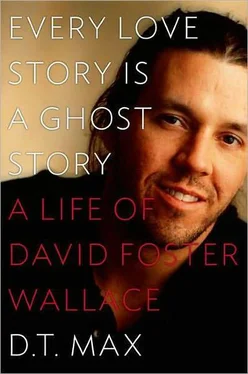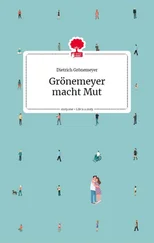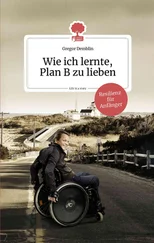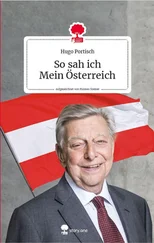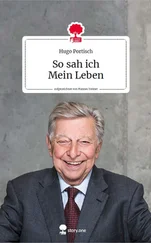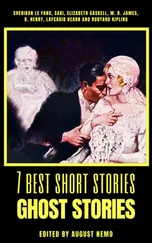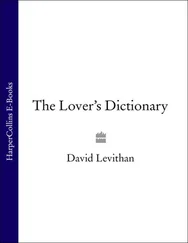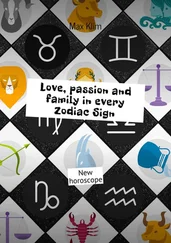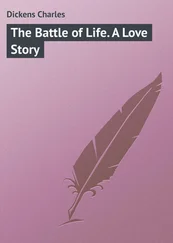Eventually, Wallace asked to go back on Nardil, but he was too agitated to give it the weeks it takes to work. Franzen would call and encourage him to stick with it — the worst was over. “Keep talking like that,” Wallace said. “It’s helping.” In early September, Nadell spoke with him and thought that he sounded a bit better. He was writing notes to himself, making gratitude lists and lists of symptoms and fears and keeping a journal. In his last entry he wrote that he would stay awake so that when Green got home he could help her with the groceries.
Green believes that she knows when Wallace decided to try again to kill himself. She says of September 6, “That Saturday was a really good day. Monday and Tuesday were not so good. He started lying to me that Wednesday.” He waited two more days for an opportunity. In the early evening on Friday, September 12, Wallace suggested that Green go out to prepare for an opening at Beautiful Crap, which was about ten minutes away in the center of Claremont. Green felt comforted by the fact that he’d seen the chiropractor on Monday. “You don’t go to the chiropractor if you’re going to commit suicide,” she says.
After Green left, Wallace went into the garage and turned on the lights. He wrote her a two-page note. Then he crossed through the house to the patio, where he climbed onto a chair and hanged himself. When one character dies in Infinite Jest , he is “catapulted home over…glass palisades at desperate speeds, soaring north, sounding a bell-clear and nearly maternal alarmed call-to-arms in all the world’s well-known tongues.”
Green returned home at 9:30 and found her husband. In the garage, bathed in light from his many lamps, sat a pile of nearly two hundred pages. He had made some changes in the months since he considered sending them to Pietsch. The story of “David Wallace” was now first. In his final hours, he had tidied up the manuscript so that his wife could find it. Below it, around it, inside his two computers, on old floppy disks in his drawers were hundreds of other pages — drafts, character sketches, notes to himself, fragments that had evaded his attempt to integrate them into the novel over the past decade. This was his effort to show the world what it was to be “a fucking human being.” He had never completed it to his satisfaction. This was not an ending anyone would have wanted for him, but it was the one he had chosen.
David Foster Wallace and I never met. The closest we came was at a party in 1996 for Infinite Jest —the publishing party he would later tell Don DeLillo was the only one he’d ever gone to “and if God’s in his heaven it will be my last.” I had commissioned a piece on Infinite Jest for a magazine where I was a features editor, and so I was there in that large room with several hundred others. I was amazed to see a stocky man with long scraggly hair and a bandana, some sort of grimy shirt, granny glasses, and that expression of a deer who wishes it was anywhere but on this road. He was across a vast dance floor spot-lit. At least that’s my memory.
Because we never spoke and because he died so young, when I began to write his biography I had to look for his voice elsewhere. I turned to his friends and family. Fortunately for me the vast majority were open and willing to talk and pass on their memories.
I learned in the process of writing this book why the list of acknowledgments in biographies is always so long — because biography is a joint act, an exercise in communal remembering. And if it takes a village to write a biography, it takes a town to write the first biography of someone as complex as David. Herewith, some of the kindly residents. To all I apologize for the countless emails and repeated phone calls, the thing I asked you that I had already asked you before, the desperate requests for clarification right when you were sitting down to dinner. All I can say is Thank You. Thank you.
First, my deepest appreciation to Karen Green, David’s gracious and gifted wife.
I received welcome support also from Wallace’s family, especially his sister, Amy, a person of caring and poise. To Bonnie Nadell, who was Wallace’s superb agent for his entire career (they met in their early twenties), I owe a significant debt of gratitude. I’d like also to point out three of Wallace’s friends who gave more help than I had the right to ask for. The first is the novelist Mark Costello, David’s roommate at Amherst. A second is Heather Aronson, David’s good friend from Arizona and a talented fiction writer too. The philosophical Corey Washington, also a friend of David’s from Amherst, showed an inexhaustible willingness to help on everything, from the minutiae of David’s Amherst grades to questions of free will and fatalism.
David had deep friendships with two other writers who helped me enormously: Jonathan Franzen, his “best of pals and lit combatant,” as Wallace called him, was one who was with him to the end. Mary Karr, the poet and memoirist, played an important role in an earlier part of his life. To Mary I owe a particular debt for helping me try to figure out what went on during David’s tumultuous Boston and Syracuse years. Any failure to make sense of these bafflingly complex days is, of course, mine (ditto errors of all sorts that may be in these pages).
There were many other writers whom Wallace knew or corresponded with in his later years. Many were kind enough to give me their recollections, among them Sherman Alexie, Tom Beller, Sven Birkerts, Tom Bissell, Don DeLillo, Dave Eggers, Jeffrey Eugenides, Lewis Hyde, Frederick Kaufman, Brad Leithauser, Mark Leyner, Ruth Liebmann, Richard Powers, George Saunders, David Sedaris, Evan Wright, and Elizabeth Wurtzel.
Now to those kind souls not mentioned above who helped as I worked my way through each of David’s ports of call in his too-short life. This list does not aim to be comprehensive — as Wallace wrote about the difficulty of writing about real life, “There’s so much!”
In Urbana: Mrs. Clare Barkley, Thomas Desmond, the Dessouky brothers, Maged and Yasser, John Flygare, Matt Friedman, David Ghent, Martin Maehr, Michail Reid, Brian Spano, Sherry Thompson (Mrs. McLellan when she taught at Urbana High), and Lolita Zwettler.
At Amherst: Ruth Abbe, Fred Brooke, Sylvia Kennick Brown, David Chinitz, Dave Colmar, Rajiv Desai, Willem DeVries, John Drew, Jay Garfield, Shubha Ghosh, Jonathan Glass, David Hixon, Ann Huse, Dan Javit, Andrea Justus, Nancy Kennick, Nat Larson, Brad Leithauser, Alan Lelchuk, Miller Maley, Charlie McLagan, Andrew Parker, Dale Peterson, and Mark Valladares.
In Arizona: Jaci Aaronson, Forrest Ashby, Robert Boswell, Karen Brennan, Rich C., Andy Crockett, Alice Elman, Alison Hicks Greifenstein, Ron Hansen, Bob Houston, Zita Ingham, JT Jackson, Ken Kalfus, Rick Kempa, Will Layman, Antonya Nelson, Paul Niesen, the late Steve Orlen, Amy Pence, Jonathan Penner, Bruce Petronio, Buzz Poverman, Francine Prose, Kim Roberts, Andy Robinson, Aurelie Sheehan, Charles Sherry, and Ron Steffens.
At Yaddo: Marina Budhos, Kathe Burkhart, Robert Cohen, Stephen Dunn, Marie Howe, Jeanne McCulloch, Jay Mclnerney, and Michael Torke. I would also like to thank Elaina Richardson and Lesley Leduc for the copies of David’s applications to Yaddo.
As a teacher at Amherst: Sue Dickman, Tias Little, Margit Longbrake, John Reid, and Jessamyn West. As a teacher (briefly) in Arizona: Marvin Diogenes, Martha Ostheimer, and Tom Willard. As a graduate student at Harvard: Steven Affeldt, Roy Blumenfeld, Warren Goldfarb, Steven Gross, Mi-Kyoung Lee, Alva Noe, and Dmitri Tymoczko. At Granada House: Big Craig and Deb Larson. At Emerson: Jack Gantos, DeWitt Henry, Don Lee, and Debra Spark. In Syracuse: Doug Eich, John F., Stephanie Hubbard, Stephen J., Christopher Kennedy, Michael Martone, and Linda Perla.
Читать дальше
